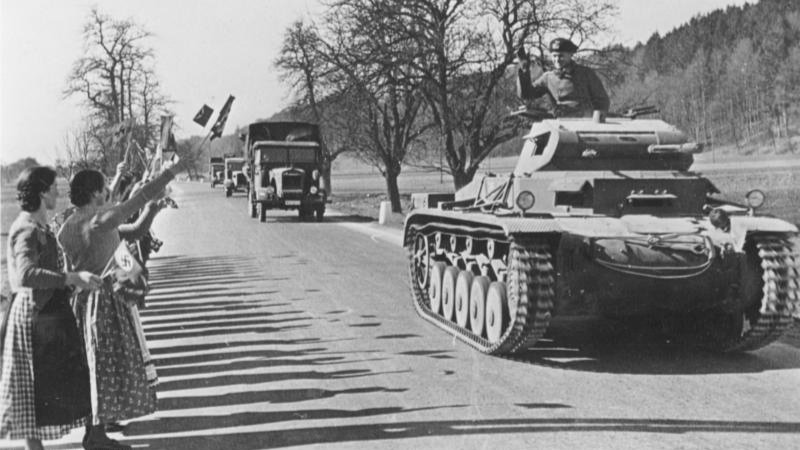Western states are beginning to send signals saying that they are ready to reach an agreement with the Kremlin under certain conditions in order to put an end to the war and to minimise the damaging consequences it can have for the rest of the world. The New York Times published an article stating that Ukraine should be ready to give up a part of its territory in order to achieve a truce. The Italian Foreign Ministry proposed a conflict regulation plan. Germany is stalling the delivery of weapons to Ukraine, while Chancellor Olaf Scholz and French President Emmanuel Macron are holding hours-long phone calls with Putin.
We asked historian Andrey Zubov to talk to our readers about certain historic parallels with what is happening now.
The Munich Agreement has been mentioned a great deal since 2014, by journalists and politicians alike. In 1938, appeasing the aggressor led to a World War that took the lives of up to 80 million people. While some nations feared war, others wished to conquer the Lebensraum, or “living space” of others, which led to the greatest catastrophe in the history of mankind. Now, we can say with confidence that had the countries that strived for peace been resolute enough to use force against the aggressor when it counted, the war, if it came to it, would have been much less bloody. However, would this imaginary war have led to 75 years of peace in Europe? That’s the big question.
In any case, lasting peace in Europe was disrupted by Russian aggression against Ukraine, which started in 2014 and took a horrifying turn on 24 February 2022, taking the form of a full-scale war. Once again, the part of the global community striving for peace is faced with a decision: to fear the war and tolerate aggression, or to take resolute action and side with the victim? This is an open question. Both decisions have their own pros and cons, and we cannot know for sure the consequences of each one of them. And although history never repeats itself completely, knowledge of the past can help us avoid certain mistakes in the future.
***
In the mid-1930s, Germany’s Reichsführer Adolf Hitler embarked on a quest to abolish the world order established by the Treaty of Versailles and to expand his domain. On 13 January 1935, Saarland, then administered by the League of Nations, voted almost unanimously in favour of reunification with Germany. A total of 90.73% opted for reunification, with voter turnout hitting a whopping 98%. Many opponents of Nazism were forced to flee from Saar to France, Czechoslovakia or Austria. On 1 March 1935, the League of Nations handed over this region to Germany. The procedure was completely legal, with German newspapers proclaiming that the Reich had taken the first step towards the recovery of the German Empire, broken apart by the Treaty of Versailles.
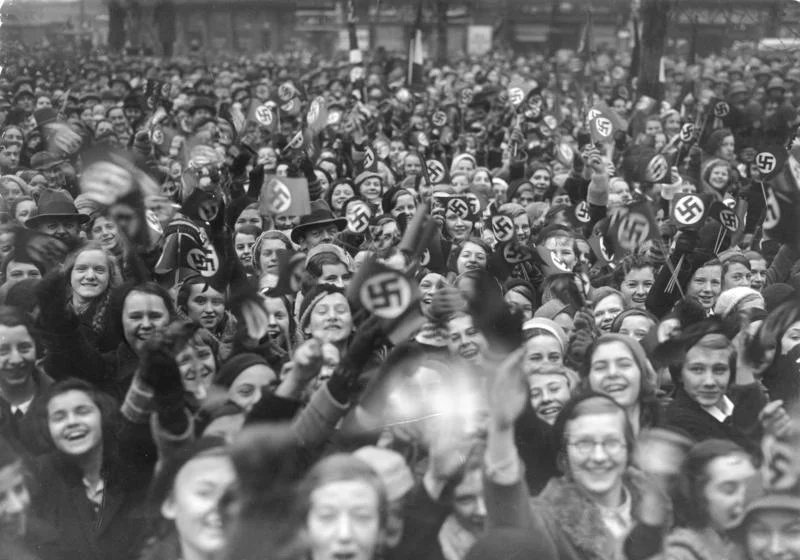
Local residents on the streets of Saar during the vote, 1935. Photo: Bundesarchiv
There were no more legal “reunifications” after that. A year later, in March 1936, German troops entered the Rhineland in violation of the Treaty of Versailles and the Locarno Treaties. Saar was located in the southern part of the Rhineland.
Germany used the 1935 Franco-Soviet Treaty of Mutual Assistance as a pretext, claiming that the Reich was “surrounded by hostile states.”
Remilitarisation of the Rhineland enabled France to use force against Germany, obligating the UK and Italy, Locarno guarantor states, to aid France in any way possible. Chief of the German General Staff Ludwig Beck warned Hitler that the Wehrmacht would not be able to counter the French army even for one day. Hitler assured Beck that if France chose to use force, Germany would withdraw its troops from the Rhineland. The balance of forces was not in Germany’s favour, but Hitler took a risk hoping for the lack of resolve and unity among Western states. His gamble paid off: the UK and Italy dodged their obligations as Locarno guarantor states, and France did not dare to act alone, limiting itself to loud displays of protest. The League of Nations condemned Germany’s violation of international treaties; however, it did not introduce any sanctions against the Reich. The scot-free annexation of the Rhine demilitarised zone led the Wehrmacht to the French border and reduced the capability of France to provide military aid to its allies in eastern Europe. The authority of France as one of the great powers had taken a significant hit.
On the one hand, this policy of “appeasement” was caused by London and Paris fearing the Stalin-led USSR. Compared to the Moscow despot, Hitler seemed like a “European” politician, a more determined “copy” of the dramatic Benito Mussolini, the leader of Italian fascism who was knee-deep in in a colonial war in Ethiopia at the time. On the other hand, the memory of the enormous human toll of the First World War was still fresh among the Triple Entente states. European politicians thought that Hitler would be satisfied with the Rhineland, and bloodshed could be avoided.
In the winter of 1936-1937, Stalin made the first attempt to strike a deal with Hitler. It was clear to the Soviet leader that the rapprochement of Moscow and Berlin would put a bomb under peace in Europe, which he saw as a positive factor that could help expand the Soviet domain. In December 1936, Walter Krivitsky, head of the Soviet intelligence network in the West, was instructed to scale down intelligence operations in Germany in order to create a favourable climate for the Soviet-German rapprochement.
In January 1937, Stalin ordered David Kandelaki, the Soviet trade representative in Berlin at the time, to communicate the USSR’s desire to improve political relations with Germany and to sign possible diplomatic agreements in the future. Kandelaki spoke to Hjalmar Schacht, President of Germany’s Central Bank, and Hermann Göring, one of Hitler’s closest allies. However, on 11 February 1937, German Foreign Minister Konstantin von Neurath informed Schact that Hitler had rejected the Soviet proposal. Germany explained its refusal to cooperate by the subversive activity of the Communist International (Comintern) and the 1935 Franco-Soviet Treaty of Mutual Assistance, however, it did not rule out the possibility of German-Soviet cooperation in the indefinite future. Krivitsky, who soon defected from the Soviet Union, later wrote: “Hitler himself was the main obstacle in the way of reaching an understanding with Moscow.” Possibly, Hitler could see the benefits of a temporary alliance with the Bolshevik despot, however, he did not need one in 1937, fully focused on Western expansion at the time.
In October 1936, Germany and Italy reached an agreement on economic partnership and on the delineation of the countries’ spheres of influence, the so-called Berlin-Rome Axis. In November 1936, Germany and Japan signed the Anti-Comintern Pact, taking on the obligation to do nothing to improve the position of the USSR in case of a war. In December, Italy and Japan signed an agreement recognising the countries’ territorial acquisitions (in Ethiopia and Manchuria). Italy’s decision to join the Anti-Comintern Pact in November 1937 finalised the establishment of the so-called Axis powers, a military bloc aimed to demolish the remnants of the Versailles-Washington system of international relations. Emboldened by the alliance with Italy and Germany, Japan launched an invasion of China in July 1937.
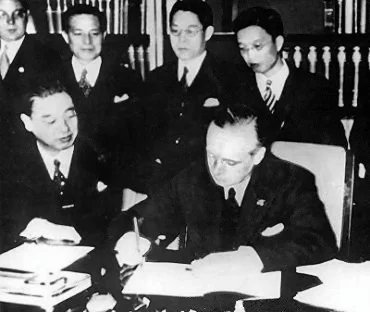
Ambassador of Japan to Nazi Germany Kintomo Mushanokōji and Joachim von Ribbentrop, who served as German ambassador-at-large at the time, signing the Anti-Comintern Pact. Photo: iwm.org.uk
On 5 November 1937, Hitler gathered the Wehrmacht command for a meeting at the Reich Chancellery. Foreign Minister Konstantin von Neurath was also in attendance.
The Führer then proceeded to uncover his plans to overcome the racial threat to the Arian nations from the Untermenschen by seizing the Lebensraum and establishing the Great German Empire. Austria, Sudetenland and Czechoslovakia were to become the first step towards the established goal, Hitler told his shell-shocked audience. They would serve as the initial industrial and agricultural base for the Reich. After that, Hitler planned to take Poland.
Neurath, the first Minister of War Werner von Blomberg and Commander-in-Chief of the German Army Werner von Fritsch strongly opposed Hitler’s plan, justified in thinking that a war with the West would lead Germany to a catastrophe. While the annexation of Austria and Sudetenland could be seen as reunification of ethnic Germans within one state, attempts to seize Czechoslovakia and then Poland would inevitably provoke a full-scale war, which Germany would inevitably lose due to a lack of resources. This was the opinion of Hitler allies who valued reason.
For the first time ever, the officials who served under Hitler began to doubt the feasibility of his plans. For his part, the Führer became convinced of the fact that German conservatives wished Germany to return to greatness, yet they opposed adventurous plans; they supported the expansion of the Wehrmacht, yet they opposed war; they supported the National-Socialist order, yet they did not share the National-Socialist worldview. Enraged, Hitler ousted all three officials within a few months.
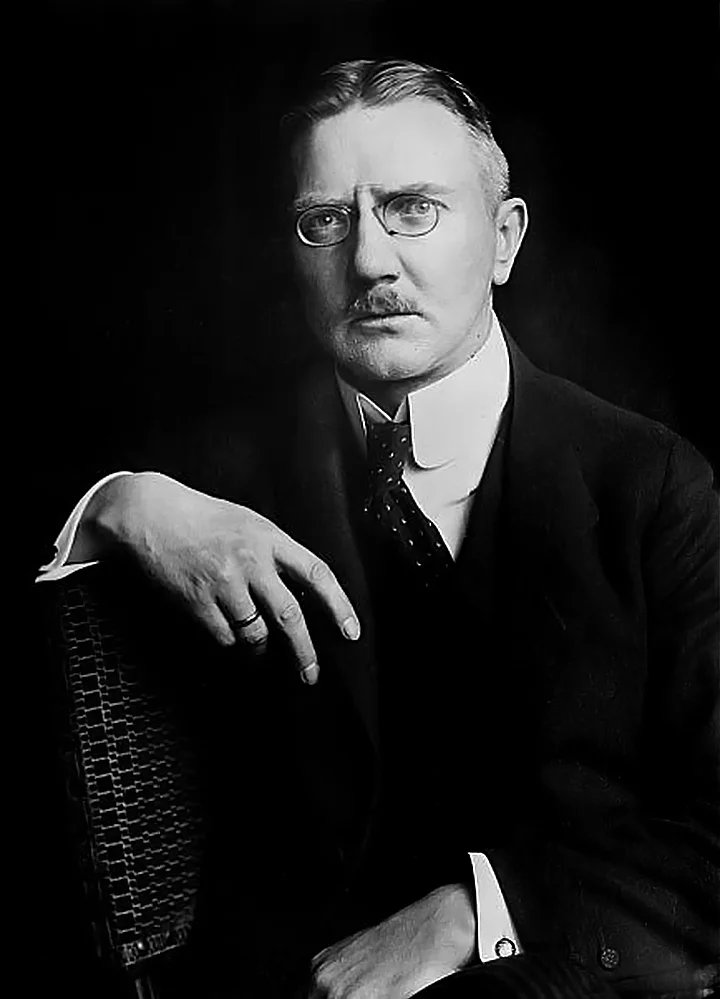
German government official and economist, Reichsminister of Economics (1936-1937) Hjalmar Schacht. Photo: Library of Congress, USA
Werner von Blomberg resigned on 25 January 1938. The Ministry of War was disbanded 10 days later, replaced with the Armed Forces High Command (Oberkommando der Wehrmacht, or OKW), led by General Wilhelm Keitel. On the same day, von Fritsch was replaced with Colonel General Walther Heinrich von Brauchitsch. In addition to that, Hitler ordered 16 older generals to retire, and 44 generals were forced to resign. Joachim von Ribbentrop, who had the Führer’s full trust, succeeded Neurath as Foreign Minister in 1938. Even earlier, in September 1937, brilliant economist Hjalmar Schacht, who openly criticised the policies of the Nazi Party, was forced to resign as Minister of Economics. He was succeeded by devout Nazi Walther Funk.
The 1937 meeting was the beginning of Hitler’s conflict with Germany’s conservative elites, which led to several assassination attempts against the Führer. After getting rid of the remaining conservative elites in the Wehrmacht and the German Foreign Ministry, Hitler focused on the implementation of the previously announced plans.
There is no doubt that a second Triple Entente (an alliance between Russia, France and the UK) would have put an end to any German expansion in 1938. However, the problem was that the Russian Empire, which played a key role in European politics since the 18th century, had been gone for 20 years at that point. A different state took its place, with completely different goals and objectives.
Western democracies had refused to see the strengthening of German Nazism and Japanese militarism as a significant threat for a long time. Neither the French nor the English wanted to go to war. The UK was especially active in promoting the policy of appeasement, whose leadership, the Conservative government led by Neville Chamberlain, saw a strong Germany as an effective counteragent to the USSR. Meanwhile, the US wanted to wait out the European disputes across the ocean, following the neutrality laws of 1935 and 1937, which banned export of weapons and military equipment to warring countries. France, which feared Hitler’s Germany the most, did not dare to take a stand against it alone, and begrudgingly followed the British line of policy.
The growing disgust towards the Stalin regime also served as another obstacle in the way of European unification against Nazi Germany. The Soviet Union was not seen by Western democracies as a reliable or honourable partner.
***
The Great Purge significantly changed the attitude of Western states towards the Soviet Union. During the toughest years of the 1929-1933 economic crisis in the West, especially in liberal and leftist circles, there was a great deal of interest to the planned “Soviet experiment”, which seemed to have put an end to mass unemployment and declines in production, ensuring rapid economic expansion. The West knew very little about the human toll of collectivisation and the Holodomor (a man-made famine in Soviet Ukraine that killed millions of local residents) at the time, and no one could even conceive that the famine was deliberately organised by the state. That seemed impossible, as it was too terrible to imagine.
The rise of “great power” sentiments and cultural conservatism among the Bolsheviks, as well as the approval of a democratic-sounding Constitution in 1936, gave rise to hope among the Western public that the Soviet regime can be liberalised and gradually take on the form of a “normal” state. This image of a “normalising” regime was supported by the USSR’s foreign policy, which aimed to establish a system of collective security and unite all democratic powers against the Nazi-fascist threat.
The killings of top Bolshevik officials and hundreds of thousands of regular citizens, which began in 1936, put an end to these hopes. The Great Purge took place in plain sight, for the entire world to witness. Diplomats, reporters and secret agents informed the West about the scale of the purge. It became crystal clear even to the “allies” of the USSR that the country had become a personal dictatorship, ready to sacrifice the lives and wellbeing of millions, as well as the interests of the country’s economic development and security. By 1939, the Stalin regime was equated with Nazi Germany as a totalitarian and aggressive state, an enemy of universal human values and rights.
Besides, the elimination of the Red Army command, as well as experienced economists and diplomats, undermined the trust in the foreign, economic and military policy of the Soviet Union, its economic and military potential, and the capability of its armed forces.
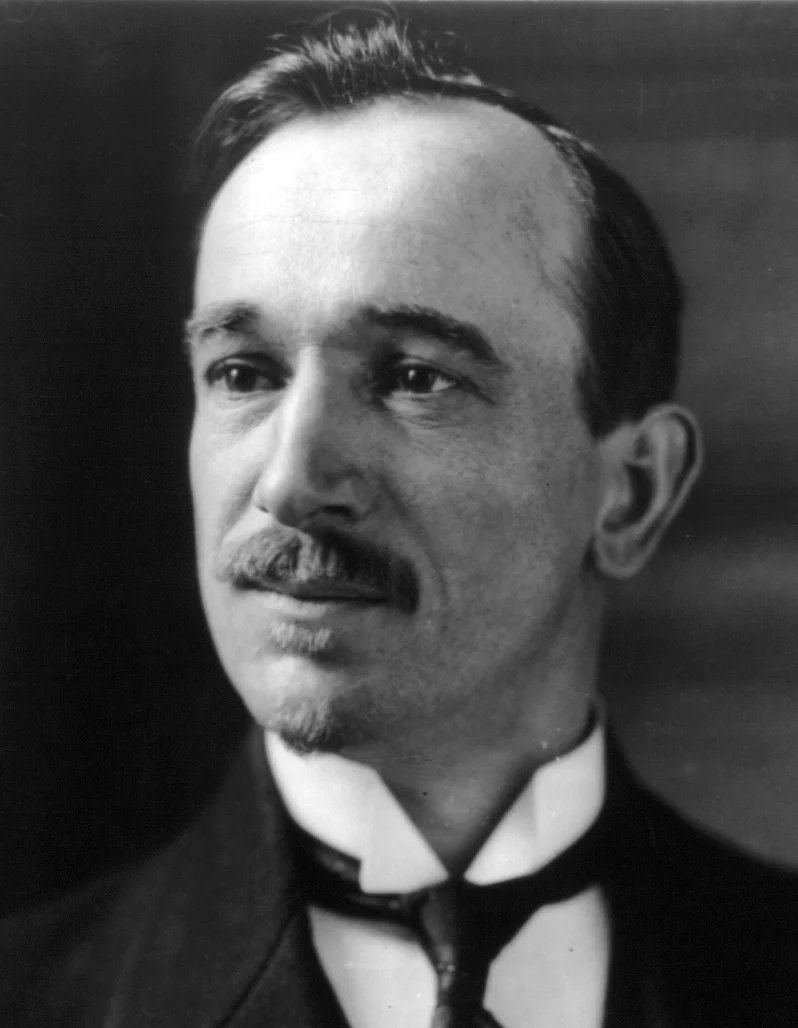
Second President of Czechoslovakia Edvard Beneš. Photo: Library of Congress, USA
Military attaches of Western states in Moscow reported a major blow to the Soviet army caused by the Purge. The French military command stopped taking into consideration the potential contribution of the Soviet Union in the country’s strategic planning, freezing the preparations for a Franco-Soviet military convention. Edvard Beneš, President of Czechoslovakia, which was also tied to the USSR by the mutual assistance treaty, talked to the Soviet envoy about “the weakening of the USSR’s international significance.” Similar signals were sent by other Western states. Hitler called the Soviet Union “a colossus on clay feet” that would fall apart after the first serious blow. Western politicians understood perfectly that after the Purge, the people would hate the Stalin regime and would not be too eager to defend it. The Stalin regime was seen in the West not just as an alien entity, but as a weak state as well.
Meanwhile, Bolshevik diplomats continued to look for allies to oppose their potential enemies, Nazi Germany and militarist Japan, as stated in the USSR’s military plans. The threat of war was rising, and in some shape or form, Stalin wished to recreate the Triple Entente to deter Germany. However, no one believed the USSR’s quest for peace after the Great Purge. Could a regime that killed thousands of its citizens and eradicated religion be a defender of democracy and independence of other states? Clearly not. All peaceful statements of Soviet top diplomat Maxim Litvinov and his successor Vyacheslav Molotov were seen as complete lies and attempts to cover up the USSR’s aggressive foreign policy aspirations, similar to what Nazi Germany was doing. Anton Denikin, former General of the Imperial Russian Army, wrote from exile in 1939: “Its hand (Soviet Russia’s – A. Z.) is seen in all global upheavals, Soviet wood is fuelling all the simmering fires” (A. I. Denikin. World Events and the Russian Question. Paris. Published by the Union of Volunteers, 1939. — P.17).
The lack of trust in the USSR among Anglo-Saxon democracies was made clear during the Spanish Civil War, when both the USA and the UK chose to maintain neutrality in the fight between nationalists and anarcho-communists.
***
Inspired by the lack of resistance, Hitler took another step towards the expansion of “ethnic borders” of the Third Reich. On 12 March 1938, after putting pressure on the Austrian government, the Wehrmacht occupied the territory of Austria, which, according to the Anschluss (or ‘the joining’) law and the results of the plebiscite held under German diktat, was incorporated into Germany. The Anschluss blatantly violated the Treaty of Versailles and the Treaty of Saint-Germain-en-Laye, however, it was seen as inevitable by Western democracies. It was followed by a formal note of protest issued by France. The UK and France even refused to discuss this issue within the League of Nations. The USSR strongly condemned the Anschluss, however, its demand to convene a European conference on countering the German aggression was ignored by the Western powers.
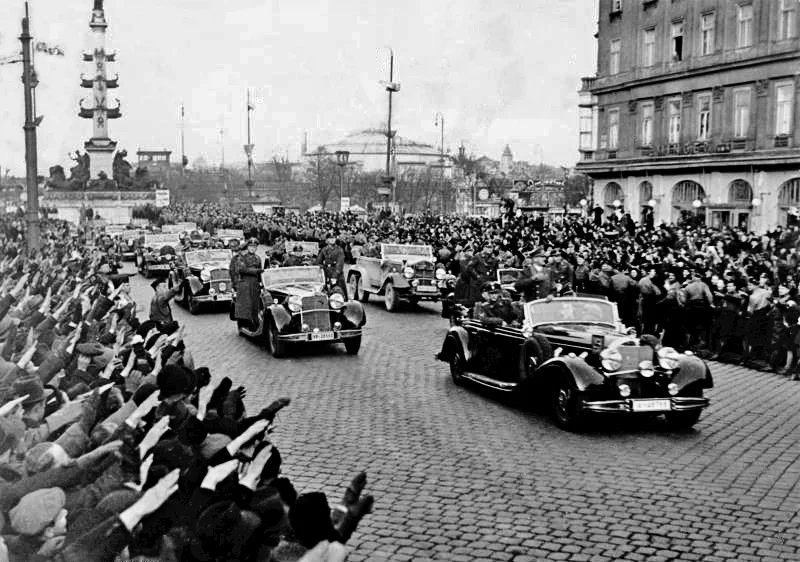
Adolf Hitler entering Vienna, 13 March 1938. Photo: Bundesarchiv
The incorporation of Austria into Germany was seen at the time as voluntary reunification of the German people within one state.
Czechoslovakia, the only parliamentary democracy among the authoritarian and totalitarian states of Central and Eastern Europe, became the next victim of Nazi expansion. In May 1938, Hitler provoked the Sudeten Crisis: based on the principle of self-determination of nations, he demanded that Germany incorporate Sudetenland, an area of Czechoslovakia with a primarily German-speaking population. If his demand was ignored, Hitler threatened to take Sudetenland by force. Meanwhile, Poland and Hungary used the situation to put forward their own territorial claims to Czechoslovakia. Poland even moved its troops to the Polish-Czechoslovakian border.
Prague was ready to fight if it received aid from France and the USSR in accordance with the mutual assistance treaties with these states. The Czech army and people were determined to take a stand against Hitler. The fortifications on the German-Czechoslovak border were constructed a short while ago under the supervision of the leading French military engineers, adhering to the highest standards. The Czechoslovak army, including tank divisions with state-of-the-art tanks built by Škoda and ČKD, was deployed to the republic’s Western borders. Despite the fact that the Wehrmacht surpassed Czechoslovakia in manpower, Czech soldiers were determined to fight against the aggressors. We can safely say that victory over Czechoslovakia, even in a one-on-one fight, would not have come easy to the Germans.
On 11 September 1938, France announced a mobilisation of troops over the possibility of German aggression against Czechoslovakia. On 19 September, Moscow confirmed its readiness to aid Czechoslovakia together with France or even unilaterally, if the League of Nations recognised Germany as an aggressor after the corresponding request by Prague. Without it, Soviet troops would not be able to move through the territory of Poland and Romania to aid Czechoslovakia, as it had no shared border with the USSR.

A convoy of German troops in Czechoslovakia, 1939. Archive footage
The Polish government understood perfectly that the Bolsheviks would not leave once they set foot in Poland, and refused to give the Soviet Union passage through its territory. Poland warned that it would declare war on the USSR if the Red Army entered the country. Romania was also afraid of the USSR, but it was willing to consider this matter if France provided security guarantees for the country. However, the French government, led by Édouard Daladier, was not willing to give those guarantees, as France did not wish to go to war with the USSR if the Soviets failed to withdraw their troops from Romania once the military operation ended.
President of Czechoslovakia Edvard Beneš did not believe the Kremlin’s guarantees, considering the USSR “an unreliable ally.” To allow the Red Army in Czechoslovakia seemed even more dangerous that the threat of the Wehrmacht: at that point, the Nazis did not even come close to the atrocities the Bolsheviks had done by 1938. The first wake-up call took place on 9 November 1938, on what is called the Kristallnacht, or the Night of Broken Glass, when Hitler organised a series of pogroms across Germany in response to the murder of a German embassy official in Paris by an immigrant Jewish person.
Complicated diplomatic manoeuvres and demonstrations of force continued throughout September. On 29-30 September 1938, Hitler, Mussolini, Daladier and Chamberlain, representing Germany, Italy, France and England, agreed to hand over the Sudetenland to Germany. In addition, some eastern districts of Czechoslovakia would be handed over to Poland and Hungary. This decision was presented to Czechoslovakia as a fait accompli. On 29 September, while the talks in Munich were still ongoing, general of the Czechoslovak Army Lev Prchala begged President Beneš during a government session in Prague to give the order to defend the country. “Whatever the great powers decide, we need to go to war. The nation is united, the army is strong and wants to fight.
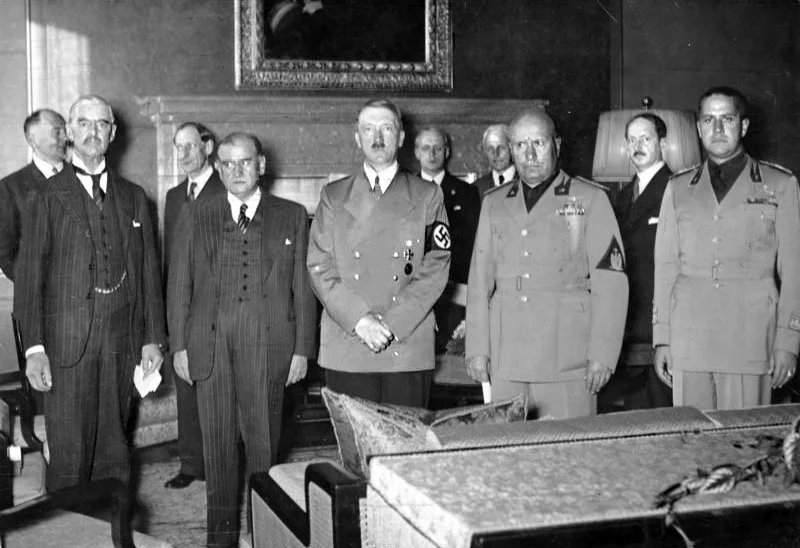
From left to right: Chamberlain, Daladier, Hitler and Mussolini during the signing of the Munich Agreement. Photo: Bundesarchiv
Even if we are on our own, without allies, we cannot give up: the army must defend the integrity of the republic, it can and it will fight.”
However, after it was made clear that neither France nor the UK would help Czechoslovakia counter the German aggression, President Beneš did not dare to go to war and accepted the ultimatum received from Munich.
“The sacrifice we’ve been forced to make is enormous and endlessly unfair,” he said on 30 September. The Czechs and the Slovaks listened to the president’s radio address with tears in their eyes. On 5 October, Beneš resigned and flew to France. As the Sudeten Crisis unfurled, Beneš kept assuring the citizens of Czechoslovakia that he had a “secret plan” that would save the country (this plan really did exist: Beneš offered to give up a part of the Sudetenland, as well as to relocate one million Germans from Czechoslovakia to Germany. Hitler rejected this plan). Now, the Czechs sadly joked among themselves: “The secret plan was the aeroplane.” The Munich Agreement was denounced only in 1942 by the Anti-Hitler Coalition member states, including the USSR. They recognised all decisions made regarding the territorial integrity of Czechoslovakia after 28 September 1938 as null and void.
It was clear to everyone that the UK and France had shamefully betrayed their ally, Czechoslovakia, which was ready to fight for its freedom. During a session of the British parliament, the main opponent of Chamberlain within the Conservative Party, a resolute anti-Nazi and anti-communist Winston Churchill said these prophetic words to the Prime Minister: “You were given the choice between war and dishonour. You chose dishonour and you will have war.”
Germany seized half of Czechia and Moravia by 10 October. Hungary took away the southern part of Slovakia and Carpathian Ruthenia in the period from 5 November to 10 November. Even Poland got a piece of western Cieszyn region and several settlements on the border with Slovakia. What was left of Czecho-Slovakia (what it was now called) only existed for six months. On 14 March 1939, Hitler recognized the independence of Slovakia, without asking anyone’s permission this time, and occupied Czechia the day after that, declaring it the German protectorate “Bohemia and Moravia”. On 18 March 1939, the entirety of Carpathian Ruthenia was handed over to Hungary.
On 22 March 1939, the Third Reich incorporated Memel, which had been detached from Germany after WWI and made part of Lithuania. Three-quarters of Memel’s population were ethnic Germans. During that time, Nazi supporters sang a song on the streets of Germany that went like this: “Heute gehört uns Deutschland, und morgen die ganze Welt” — “Today, Germany belongs to us, and tomorrow — the entire world!”

A parade of Kriegsmarine (the navy of Nazi Germany) officers held in the annexed Memel. Photo: uostas.info
Stalin was ready to send Soviet troops to Czechoslovakia during the Sudeten Crisis with the approval of the League of Nations. Up to 300,000 reserve officers were deployed to the Western borders of the USSR. The Kremlin also could expect that these measures would deter Germany and Poland, making “Hitler and Beck (the Polish Foreign Minister — A.Z.) believe in the possibility of a big war with our participation,” Soviet Foreign Minister Maxim Litvinov wrote to Moscow from Geneva.
Stalin did not want the Anti-Comintern Pact to include Czechoslovakia, however, he did not want to face Nazi Germany on the battlefield either. Stalin thought that the Western powers secretly planned to pit the USSR and Germany against each other over Czechoslovakia, like it happened the year before, when they fought for Spain. The Red Army did not cross neither the Polish nor the Romanian border… that time.
Many years later, Vyacheslav Molotov, who served as Soviet Foreign Minister from 1939 to 1956, later told biographer Felix Chuev about the principles of the Bolsheviks’ foreign policy at the time: “I saw my goal as Minister of Foreign Affairs in expanding the borders of our Fatherland as much as possible. And I think Stalin and I achieved this goal pretty well.” Peace, democracy and the anti-fascist front were simply smoke and mirrors, aimed to cover up the hostile designs of the Bolsheviks. Naturally, Western democracies were not eager to help Stalin on this quest, so, naturally, both totalitarian aggressor states — the Soviet Union and Nazi Germany — began taking steps towards rapprochement against the Anglo-Saxon democracies and France, which aimed for peace and were clearly opposed to expansionist policies. Stalin chose Germany 25 years after the First World War.
And then, September 1939 marked the beginning of the Second World War, which targeted the UK, France, Stalin’s USSR, and, ultimately, Hitler’s Germany.
***
We live in a different time now. International policy has changed a lot since then. However, the main lesson to take away from the Munich Agreement is more important than ever: you cannot buy peace and stability for yourself by sacrificing the integrity and security of an allied country that relies on your power and protection. War will still come to the territory of the country that disregarded its principles and international agreements. And this war will be much more terrible than the one you feared when refusing to support the victim of aggression.
